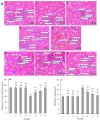Harmine mitigates cisplatin-induced renal injury in male mice through antioxidant, anti-inflammatory, and anti-apoptosis effects
- PMID: 36034080
- PMCID: PMC9400464
- DOI: 10.4103/1735-5362.350242
Harmine mitigates cisplatin-induced renal injury in male mice through antioxidant, anti-inflammatory, and anti-apoptosis effects
Abstract
Background and purpose: Cisplatin is a chemotherapeutic drug used to treat cancer, however, causes kidney toxicity. Harmine is a plant-derived alkaloid with a wide range of therapeutic applications. The effects of harmine on the renal side effects of cisplatin in mice were studied in this study.
Experimental approach: Forty-eight male BALB/c mice were randomly divided into eight groups (n = 6). They were treated with saline, cisplatin (5.5 mg/kg), harmine (5, 10, and 15 mg/kg/day), cisplatin + harmine (5, 10, and 15 mg/kg/day), respectively. All administrations were done daily and intraperitoneally for 4 days. The criteria related to histology, oxidation, anti-oxidation, inflammation, and apoptosis of renal tissue were evaluated.
Findings / results: There was a significant decrease in total antioxidant capacity of renal tissue, renal corpuscles diameter, and IL-10 expression level in the cisplatin group than in the control group, while the values of these parameters were significantly similar to the control group in the moderate or high doses of harmine + cisplatin groups. There were significant increases in serum urea and creatinine levels, bowman space, the amounts of malondialdehyde, apoptosis rate, and TNF-α, NF-κB, IL-1β, and caspase-3 gene expressions in kidney tissue of the cisplatin group compared to the control group, while these criteria did not differ in the moderate or high doses of harmine + cisplatin groups.
Conclusion and implications: Harmine protected the kidneys against cisplatin-induced damage. Antioxidant, anti-inflammatory, and anti-apoptotic harmine properties were involved in this healing effect.
Keywords: Antioxidants; Harmine; Oxidative stress; Toxicity.
Copyright: © 2022 Research in Pharmaceutical Sciences.
Conflict of interest statement
The authors declared no conflict of interest in this study.
Figures




Similar articles
-
Effect of Harmine on Nicotine-Induced Kidney Dysfunction in Male Mice.Int J Prev Med. 2019 Jun 7;10:97. doi: 10.4103/ijpvm.IJPVM_85_18. eCollection 2019. Int J Prev Med. 2019. PMID: 31360344 Free PMC article.
-
Harmine protects mercuric chloride kidney-induced injury by antioxidant activity in male mice: a biochemical and histological study.Res Pharm Sci. 2020 Nov 27;15(6):541-550. doi: 10.4103/1735-5362.301339. eCollection 2020 Dec. Res Pharm Sci. 2020. PMID: 33828597 Free PMC article.
-
Curcumin counteracts cisplatin-induced nephrotoxicity by preventing renal tubular cell apoptosis.Ren Fail. 2016 Nov;38(10):1741-1748. doi: 10.1080/0886022X.2016.1229996. Epub 2016 Oct 19. Ren Fail. 2016. PMID: 27758164
-
Amelioration of Cisplatin-induced Renal Inflammation by Recombinant Human Golimumab in Mice.Curr Pharm Biotechnol. 2022;23(7):970-977. doi: 10.2174/1389201022666210810141139. Curr Pharm Biotechnol. 2022. PMID: 35135447
-
Reduction of cisplatin-induced renal and hepatic side effects in rat through antioxidative and anti-inflammatory properties of Malva sylvestris L. extract.Biomed Pharmacother. 2018 Oct;106:1767-1774. doi: 10.1016/j.biopha.2018.07.115. Epub 2018 Jul 31. Biomed Pharmacother. 2018. PMID: 30119252
Cited by
-
Honokiol inhibits the growth of hormone-resistant breast cancer cells: its promising effect in combination with metformin.Res Pharm Sci. 2023 Aug 20;18(5):580-591. doi: 10.4103/1735-5362.383712. eCollection 2023 Sep-Oct. Res Pharm Sci. 2023. PMID: 37842518 Free PMC article.
-
Curcumin supplementation prevents cisplatin-induced nephrotoxicity: a randomized, double-blinded, and placebo-controlled trial.Res Pharm Sci. 2023 Nov 23;18(6):648-662. doi: 10.4103/1735-5362.389952. eCollection 2023 Dec. Res Pharm Sci. 2023. PMID: 39005571 Free PMC article.
-
Phytocompounds from Amazonian Plant Species against Acute Kidney Injury: Potential Nephroprotective Effects.Molecules. 2023 Sep 2;28(17):6411. doi: 10.3390/molecules28176411. Molecules. 2023. PMID: 37687240 Free PMC article. Review.
-
Thymoquinone mitigates diclofenac-induced hepatorenal toxicity in male Wistar rats by balancing the redox state and modulating Bax/Bcl-2/caspase-3 apoptotic pathways and NF-κB signaling.Res Pharm Sci. 2025 Feb 20;20(1):95-108. doi: 10.4103/RPS.RPS_141_24. eCollection 2025 Feb. Res Pharm Sci. 2025. PMID: 40190828 Free PMC article.
-
Harmine exhibits anti-apoptotic properties and reduces diabetes-induced testicular damage caused by streptozotocin in rats.Clin Exp Reprod Med. 2024 Dec;51(4):324-333. doi: 10.5653/cerm.2023.06254. Epub 2024 May 17. Clin Exp Reprod Med. 2024. PMID: 38757277 Free PMC article.
References
-
- Pabla N, Dong Z. Cisplatin nephrotoxicity: mechanisms and renoprotective strategies. Kidney Int. 2008;73((9)):994–1007. DOI: 10.1038/sj.ki.5002786. - PubMed
-
- Manohar S, Leung N. Cisplatin nephrotoxicity: a review of the literature. J Nephrol. 2018;31(1):15–25. DOI: 10.1007/s40620-017-0392-z. - PubMed
-
- Santos NA, Catao CS, Martins NM, Curti C, Bianchi MLP, Santos AC. Cisplatin-induced nephrotoxicity is associated with oxidative stress, redox state unbalance, impairment of energetic metabolism and apoptosis in rat kidney mitochondria. Arch Toxicol. 2007;81(7):495–504. DOI: 10.1007/s00204-006-0173-2. - PubMed
LinkOut - more resources
Full Text Sources
Research Materials
